IoT in Retail Market Size
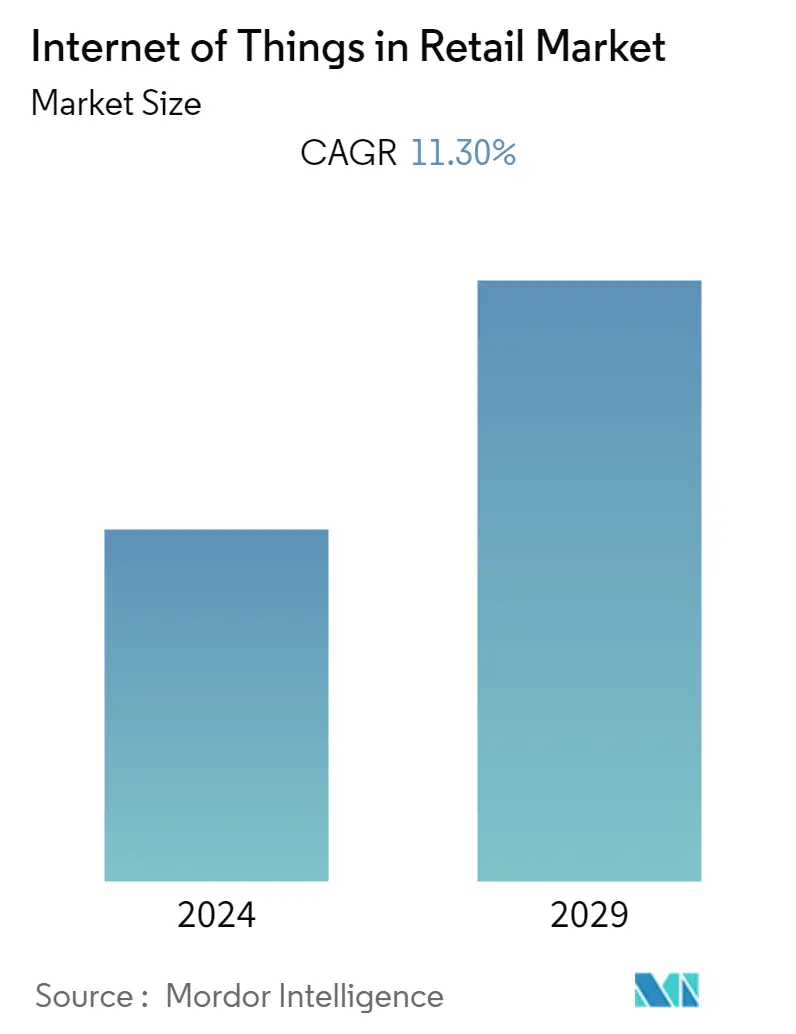
| Study Period | 2019 - 2029 |
| Base Year For Estimation | 2023 |
| CAGR | 11.30 % |
| Fastest Growing Market | Asia Pacific |
| Largest Market | North America |
| Market Concentration | Low |
Major Players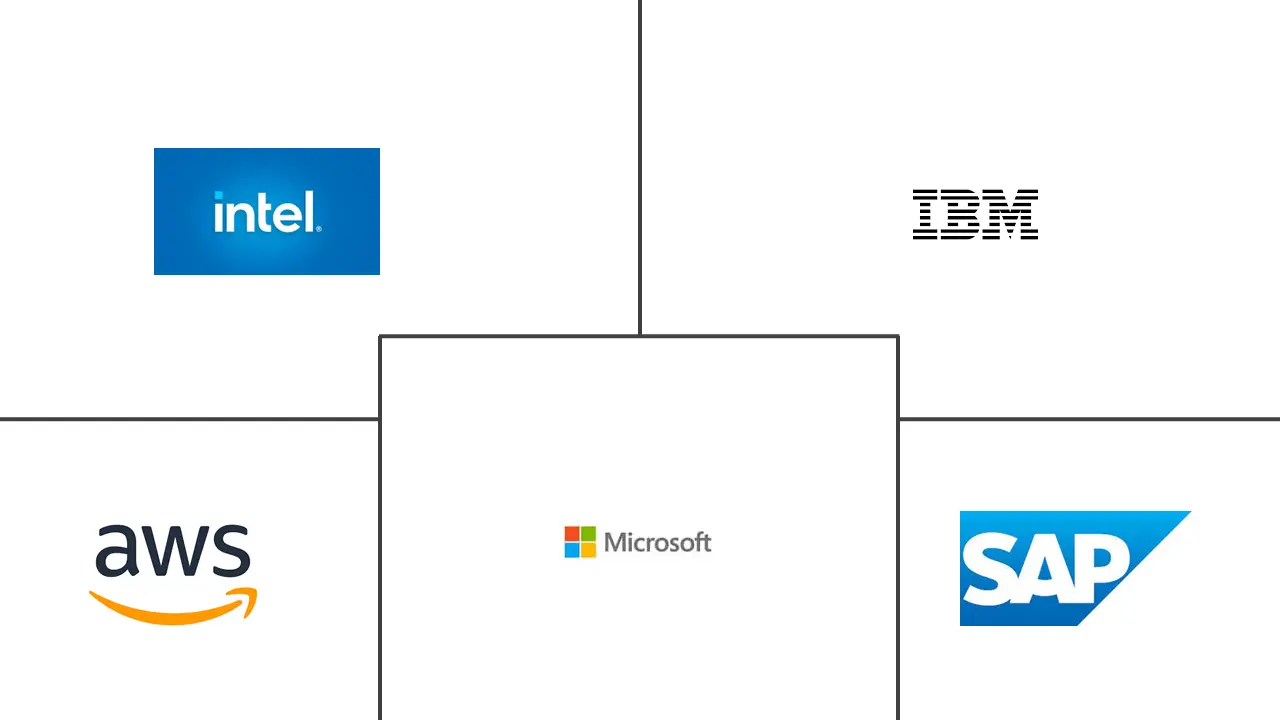
*Disclaimer: Major Players sorted in no particular order |
IoT in Retail Market Analysis
The global internet of things in the retail market is expected to witness a CAGR of 11.3% over the forecast period. The retail industry saw a significant impact from IoT in terms of boosting profitability and offering an enhanced omnichannel experience to retailers. With an existing network infrastructure likely to be used for 'connected things,' the investments and expenditures on analytics are projected to be high as companies strive to find new ways to analyze the significant volumes of smart device-generated data, augmenting the overall market's growth rate.
- IoT enables retailers to connect with both businesses and people. It allows retailers to gain insights into product performance and new ways of customer engagement with both new and existing customers. Several companies, like Kroger, Zara, Walmart, Tesco, etc., have launched smart devices to improve customer experience.
- Additionally, the e-commerce platform's use is rapidly increasing owing to the ease of shopping and smartphone penetration, which will likely boost the market. The increasing need for data analysis and analytics integration is expected to propel the utilization of the Internet of Things market over the forecast period. For instance, Amazon's first store in Seattle, the United States, is incorporated with a self-checkout service and mobile payment methods available on Android and iOS systems. The store is equipped with cameras, sensors, and RFID readers to identify shoppers and products and uses computer vision, deep learning algorithms, and the 'sensor fusion.'
- Also, with the advancement of artificial intelligence (AI) and augmented reality (AR) in retail establishments, the retail environment underwent a seismic shift. Retailers employ AI to identify the target market, comprehend the purchasing habits of past consumers, and provide customers with personalized product advertisements. For instance, in January this year, Google Cloud said it would launch four new artificial intelligence technologies aimed at retailers. The new technologies are mainly designed to aid retailers in transforming in-store shelf-checking processes and augment e-commerce operations, delivering more fluid and natural online shopping experiences. They also include a new "self-checking AI solution" that is primarily built on Vertex AI and leverages Google's extensive databases to provide retailers recognize "billions of products" and ensure that in-store shelves are well-stocked.
- However, with the rise in various security-related concerns and interoperability issues, the market's overall growth rate might get restrained throughout the forecast period.
- The pandemic significantly impacted IoT spending globally, especially in the retail sector. The merchants have postponed several new initiatives as their main priority during the economic crisis was maintaining corporate operations. As a result, IoT's retail market saw a revenue fall during the pandemic. However, it is anticipated that IoT use in retail will progressively rise after COVID-19. To eliminate human involvement and stop the coronavirus from spreading, retailers are already integrating AI technologies, cloud services, mobile payment systems, autonomous cleaning robots, and many others.
IoT in Retail Market Trends
This section covers the major market trends shaping the IoT in Retail Market according to our research experts:
Software Component Expected to Hold Significant Share
- The significant growth of internet shopping can be attributed to higher transaction values and increased order frequency. IoT can optimize supply chain management, reduce inventory error, and decrease labor costs. Ultimately, IoT can help the traditional brick-and-mortar shop compete with today's online-first shopping world by exponentially improving customer experience and reducing unnecessary expenses.
- Different software solutions providers provide IoT for the retail sector's betterment. Some of them are Qliktag, Evrythng, ThinFilm NC solutions, Gimble, Kaa Projects, Wise Shelf, Swirl, Memomi, Authentic or Not, Queuehop, and many others.
- Moreover, NFC-enabled technology creates immense growth opportunities for retailers to inform and persuade shoppers. For instance, national supermarket chain Kroger Co. piloted smart shelf tags to display product information. Moreover, the NFC provides significant functionalities to IoT by solving the challenges of unpowered objects lacking network access, providing the simplest, most intuitive way to indicate a user's interest in taking action, and connecting devices easily and intuitively. Hence, an increase in NFC solutions usage is penetrating the retail market, driving the market significantly.
- Companies like Paytm made headlines last year as it declared its plans for a USD 2.2 billion IPO. The country's highest-valued startup at USD 16 billion, the Noida-based fintech first known as One97 Communications originally started as a significant provider of digital phone payments. Still, it grew to cover insurance sales, ticket booking, and other digital financial services. PhonePe and Paytm were more commonly used than credit or debit cards for online shopping in India.
- According to the website (Boku), Google Pay, PhonePe, and Paytm are expected to grow by hundreds of millions of users in India by the end of 2025. Hence, with the rise in the number of users of mobile wallets, the market for IoT in the retail sector is expected to witness significant growth opportunities throughout the forecast period.
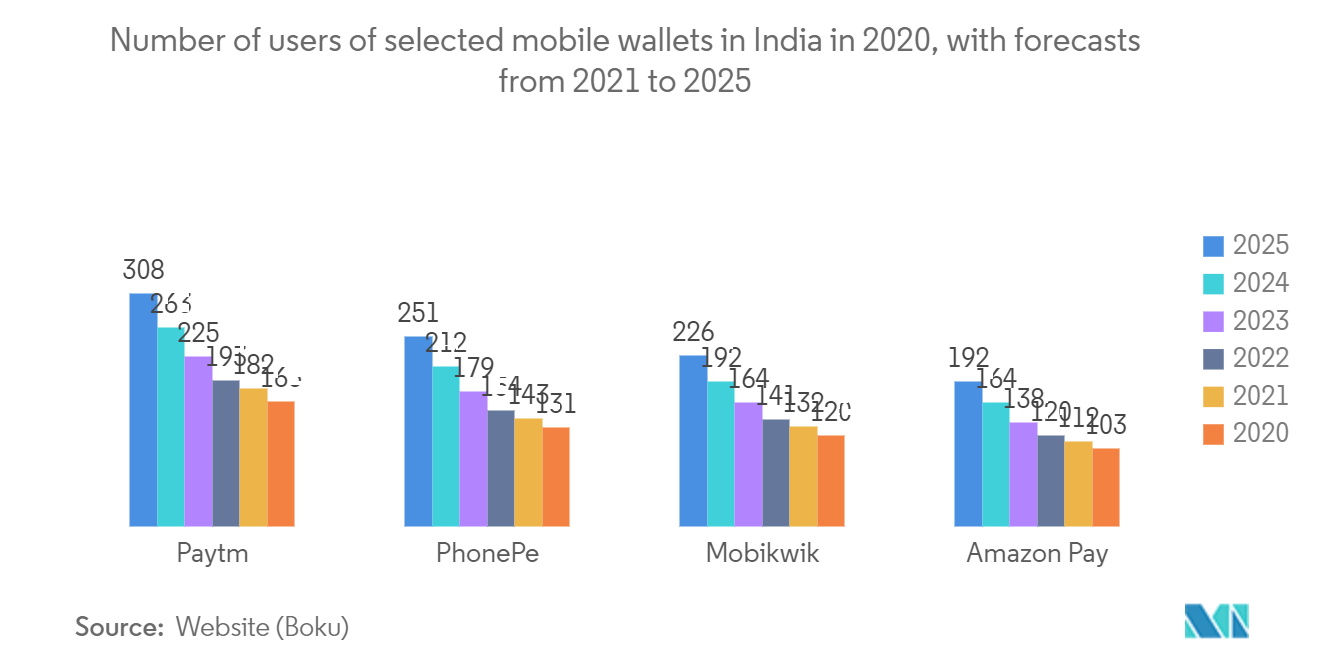
North America to Hold Largest Share
- The advent of e-commerce technologies and the incorporation of the best in-store experience have been the major factors responsible for the paradigm shift in US retailing. Retailers are prioritizing their spending toward omnichannel retailing by moving from purely online stores to brick-and-mortar stores and vice-versa.
- In addition, with an increasing number of consumers embracing the smart home environment in the United States, the expansion of IoT is on the rise across the region. As a result, retailers are aiming to develop their solutions around home assistants. The success of Alexa and Google Home are clear indicators of the trend. Also, deploying IoT to track inventory using sensors and RFID tags enables real-time management and streamlining of the entire flow. Amazon's warehouses in the United States have smart shelves, which help the retailer monitor and track inventory items, reducing human errors while reordering items and eliminating overstocking products in warehouses.
- The significant growth of internet shopping can be attributed to higher transaction values and increased order frequency owing to convenience. The retail Industry in America is divided into brick-and-mortar retailers boasting of successful online strategies and surviving the competition with Amazon. Moreover, the Internet of Things is also being widely used by retailers to provide a personalized experience to their customers. For example, Walmart uses IoT in its United States warehouses to gain insights about popular products on social media.
- Companies like Walmart, Target, and Best Buy have also found the right mix of products and services, like selling groceries, to keep shoppers coming into their stores. While Amazon remains the leader in e-commerce, these players are using their physical stores to fulfill online orders, simultaneously increasing their digital promotions.
- In December last year, Amazon planned to bring a TikTok-like shopping experience to its app. The company declared the launch of Inspire, a new short-form video and photo feed that enables consumers to explore ideas and products and shop from content created by brands, influencers, and other customers. The feature is primarily designed to draw consumers' attention away from apps like TikTok, where brands can directly market to consumers, significantly driving sales on Amazon.com instead.
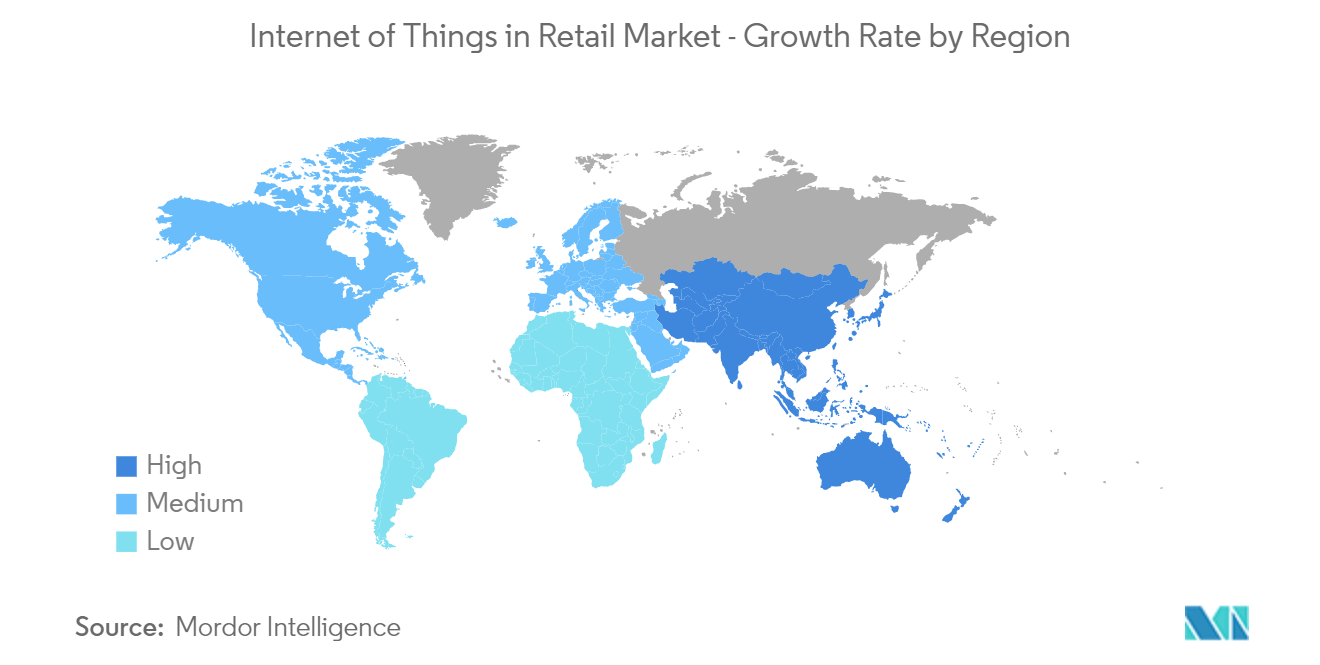
IoT in Retail Industry Overview
The internet of things in the retail market needs to be more cohesive. An increasing number of consumers embracing the smart home environment, temperature sensors deployment in warehouses, and the advent of e-commerce technologies provide lucrative opportunities in the internet of things in the retail market. Overall, the competitive rivalry among existing competitors is high. Product innovation and expansion are penetrating the industry growth effectively.
- January 2023 - EY declared the introduction launch of a retail solution that builds on the Microsoft Cloud to help achieve seamless consumer shopping experiences. The EY organization introduced a new EY Retail Intelligence solution that primarily uses the Microsoft Cloud and Cloud for Retail to offer consumers a direct and seamless shopping experience.
- December 2022 - KORE, a global leader in the Internet of Things (IoT) Solutions and worldwide IoT Connectivity-as-a-Service (IoT CaaS), declared that it had established a go-to-market alliance with Google Cloud to bring IoT capabilities to global businesses. This multi-year alliance would help enterprises create robust IoT solutions that leverage Google Cloud infrastructure and abilities, as well as KORE's IoT Solutions. In addition, the coalition would transform the IoT industry by expanding new paths to market for industries such as Fleet/Logistics, Industrial IoT, Connected Health, retail/communications service providers, and many more.
IoT in Retail Market Leaders
-
Amazon Web Services Inc.
-
IBM Corporation
-
Intel Corporation
-
Microsoft Corporation
-
SAP SE
*Disclaimer: Major Players sorted in no particular order
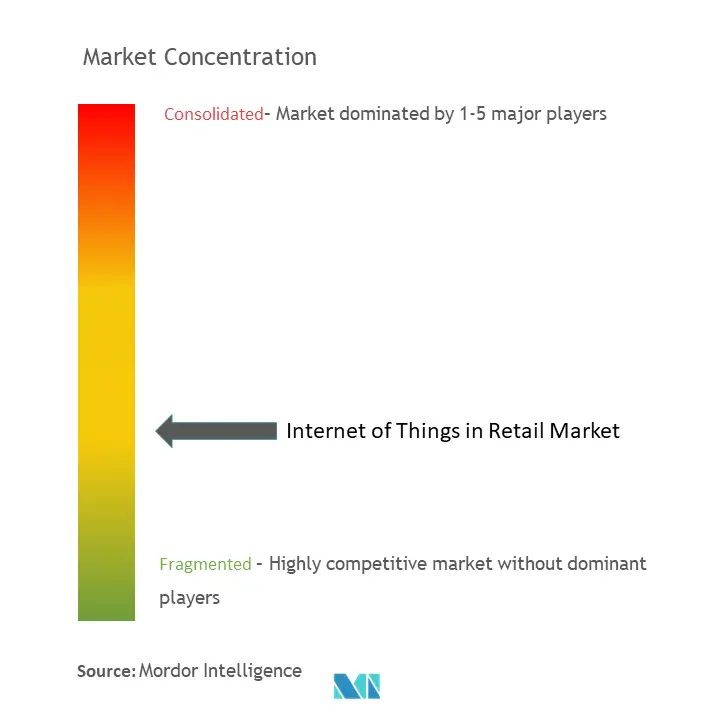
IoT in Retail Market News
- January 2023 - Wiliot, the Internet of Things pioneer whose IoT platform is enabling trillions of 'things' to gain intelligence, declared the introduction of its Innovation Kit, which equips companies of any budget and size with an easy onramp to begin building and exploring ambient IoT solutions that can solve the biggest challenges facing retail, supply chains, CPG, healthcare, agriculture, and many others.
- January 2023 - Energous Corporation, a leading developer of wireless power networks, and SATO Holdings Corporation, a global pioneer in auto-ID and labeling solutions, declared a partnership to develop joint solutions that combine Energous' 1W WattUp PowerBridge transmitters with IoT solutions for next-generation smart store applications.
IoT in Retail Market Report - Table of Contents
1. INTRODUCTION
- 1.1 Study Assumptions? and Market Definition?
- 1.2 Scope of the Study
2. RESEARCH METHODOLOGY
3. EXECUTIVE SUMMARY
4. MARKET INSIGHTS
- 4.1 Market Overview
-
4.2 Industry Attractiveness - Porter's Five Forces Analysis
- 4.2.1 Bargaining Power of Suppliers
- 4.2.2 Bargaining Power of Buyers/Consumers
- 4.2.3 Threat of New Entrants
- 4.2.4 Threat of Substitute Products
- 4.2.5 Intensity of Competitive Rivalry
- 4.3 Industry Value Chain Analysis?
- 4.4 Technology Snapshot
5. MARKET DYNAMICS
-
5.1 Market Drivers
- 5.1.1 Increasing IoT Applications Among Retailers Such As Predictive Equipment Maintenance , Connected Consumer and Smart Store
- 5.1.2 Rising Need for a Competitive Business Model to Sustain Competition
- 5.1.2.1 Competition
-
5.2 Market Challenges
- 5.2.1 Security Concerns and Interoperability Issues
6. MARKET SEGMENTATION
-
6.1 By Component
- 6.1.1 Hardware
- 6.1.2 Software
- 6.1.3 Service
- 6.1.3.1 Managed
- 6.1.3.2 Professional
-
6.2 Geography
- 6.2.1 North America
- 6.2.1.1 United States
- 6.2.1.2 Canada
- 6.2.2 Europe
- 6.2.2.1 United Kingdom
- 6.2.2.2 Germany
- 6.2.2.3 France
- 6.2.2.4 Italy
- 6.2.2.5 Rest of Europe
- 6.2.3 Asia-Pacific
- 6.2.3.1 China
- 6.2.3.2 India
- 6.2.3.3 Japan
- 6.2.3.4 Korea
- 6.2.3.5 Rest of Asia-Pacific
- 6.2.4 Latin America
- 6.2.5 Middle East & Africa
7. COMPETITIVE LANDSCAPE
-
7.1 Company Profiles
- 7.1.1 Amazon Web Services Inc.
- 7.1.2 AT&T Inc.
- 7.1.3 Ayla Networks Inc.
- 7.1.4 Bosch Software Innovations GmbH
- 7.1.5 Cisco Systems Inc.
- 7.1.6 Fujitsu Ltd
- 7.1.7 General Electric
- 7.1.8 Google Inc.
- 7.1.9 Hewlett Packard Enterprise
- 7.1.10 Hitachi Ltd
- 7.1.11 Huawei Technologies Co. Ltd
- 7.1.12 IBM Corporation
- 7.1.13 Intel Corporation
- 7.1.14 Microsoft Corporation
- 7.1.15 Oracle Corporation
- 7.1.16 SAP SE
- 7.1.17 Siemens AG
- *List Not Exhaustive
8. INVESTMENT ANALYSIS
9. FUTURE OF THE MARKET
** Subject To AvailablityIoT in Retail Industry Segmentation
IoT helps retailers to gather data and produce insights without compromising data security. As a result, retailers can maintain the basic approaches to adopting in-store connectivity (such as enabling the IoT era at the endpoints).
The Internet of Things in the Retail Market is segmented by components (hardware, software, service (managed and professional)) and geography (North America, Europe, Asia-Pacific, Latin America, Middle East & Africa). The market sizes and forecasts are provided in value (USD million) for all the above segments.
| By Component | Hardware | |
| Software | ||
| Service | Managed | |
| Professional | ||
| Geography | North America | United States |
| Canada | ||
| Geography | Europe | United Kingdom |
| Germany | ||
| France | ||
| Italy | ||
| Rest of Europe | ||
| Geography | Asia-Pacific | China |
| India | ||
| Japan | ||
| Korea | ||
| Rest of Asia-Pacific | ||
| Geography | Latin America | |
| Middle East & Africa |
IoT in Retail Market Research FAQs
What is the current Internet of Things in Retail Market size?
The Internet of Things in Retail Market is projected to register a CAGR of 11.30% during the forecast period (2024-2029)
Who are the key players in Internet of Things in Retail Market?
Amazon Web Services Inc., IBM Corporation, Intel Corporation, Microsoft Corporation and SAP SE are the major companies operating in the Internet of Things in Retail Market.
Which is the fastest growing region in Internet of Things in Retail Market?
Asia Pacific is estimated to grow at the highest CAGR over the forecast period (2024-2029).
Which region has the biggest share in Internet of Things in Retail Market?
In 2024, the North America accounts for the largest market share in Internet of Things in Retail Market.
What years does this Internet of Things in Retail Market cover?
The report covers the Internet of Things in Retail Market historical market size for years: 2019, 2020, 2021, 2022 and 2023. The report also forecasts the Internet of Things in Retail Market size for years: 2024, 2025, 2026, 2027, 2028 and 2029.
null Industry Report
Statistics for the 2023 null market share, size and revenue growth rate, created by Mordor Intelligence™ Industry Reports. null analysis includes a market forecast outlook to 2029 and historical overview. Get a sample of this industry analysis as a free report PDF download.



